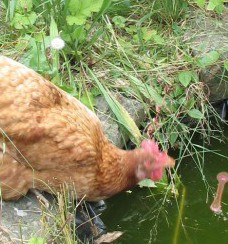Chicken Anatomy
Digestion
Knowing chicken anatomy will help you determine how your chickens break down their food and what problems may occur along the way. When food enters the beak of a chicken, it immediately begins being broken down by saliva (chickens don't have teeth).
The next place that the food enters, after the tongue pushes the food down the throat, is the esophagus. From the esophagus the food then enters the chicken's crop.
The crop is a pocket at the base of neck that holds food to be digested. Chickens can sometimes have problems with their crops, where food will get blocked.
This is commonly known as "Crop Impaction." From the crop, food moves to the proventriculus or true stomach.Enzymes break the food down further here.
It then passes on to the gizzard, or the mechanical stomach. The gizzard is built with thick strong muscles that do most of the breaking down of the food. Birds can have problems with their gizzards if they happen to eat small sharp objects such as staples or shards of glass.
From the gizzard the food then enters the small intestine for absorption. The upper portion of the small intestine, known as the duodenum forms a loop. Enclosed in the loop is the pancreas, which secretes enzymes to aid in digestion. After this loop you have the liver that secretes bile to aid in digestion.
Coming off of the small and large intestine are two blind pouches called the ceca that have no known function. The last portion of the intestine is known as the large intestine or rectum.


